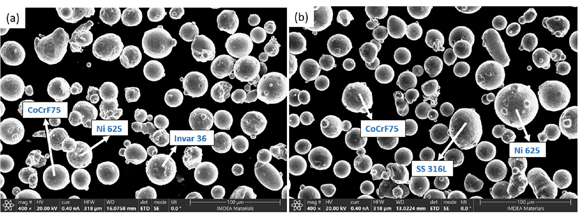Researchers use Laser Beam Powder Bed Fusion on commercial metal powders to fabricate high-entropy alloys
April 26, 2024

In a paper titled ‘Laser Powder Bed Fusion Processing of Low Cost CoCrFeNiMoxNby High Entropy Alloys with Promising High-Temperature Properties via In Situ Alloying Commercial Powders,’ authors S Venkatesh Kumaran and José Manuel Torralba, IMDEA Materials Institute, Madrid, Spain, present a new approach to the development of high-entropy alloys (HEAs). The method uses Laser Beam Powder Bed Fusion (PBF-LB) and in-situ alloying of readily available commercial powders.
HEAs have gained significant attention in recent years due to their unique microstructures and exceptional mechanical properties. However, the traditional methods of manufacturing HEAs, such as casting or arc melting, can be expensive and time-consuming, especially when dealing with alloys composed of multiple principal elements. Additionally, the use of critical raw metals in the production process raises concerns about their availability and sustainability.
To address these challenges, the authors proposed a novel method that utilises commercial powders instead of pure elemental powders for the fabrication of HEAs. By blending commercial powders — including Ni625, CoCrF75, and 316L — the authors were able to reduce the cost of raw materials while maintaining the desired alloy composition. This approach offers a more cost-effective solution and also opens up the possibility of using scrap and recycled materials for HEA development, promoting sustainable manufacturing practices.

The authors conducted their experiments using PBF-LB Additive Manufacturing and optimised the process parameters to achieve high-density samples with minimal porosity. The resulting HEAs, labelled as C1 and C2, exhibited a single face-centred cubic (FCC) phase, which is known for its excellent mechanical properties. The incorporation of high atomic size elements, such as molybdenum (Mo) and niobium (Nb), enhanced the strength of the alloys without compromising their ductility.
Tensile tests were performed on the fabricated samples at room temperature and elevated temperatures ranging from 700-900°C. The results showed that the mechanical properties of the developed HEAs surpassed those reported in existing literature on HEAs. The presence of Mo and Nb-rich precipitates at elevated temperatures contributed to the remarkable strength of the alloys. These precipitates, when distributed throughout the matrix, enhanced the strength without compromising elongation.
The authors emphasise that their work is not only a feasibility study but also a step towards the development of cost-effective HEAs using PBF-LB. By utilising readily available and cheaper commercial powders, the exploration of new HEAs should become more accessible. Furthermore, this approach is intended to reduce the reliance on critical raw metals, thus improving the efficiency and sustainability of the manufacturing process.
The paper can be read here.
Download Metal AM magazine

















